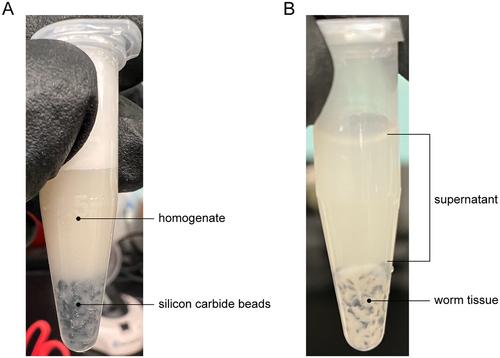{"title":"Orsay Virus Infection in Caenorhabditis elegans","authors":"Lakshmi E. Batachari, Mario Bardan Sarmiento, Nicole Wernet, Emily R. Troemel","doi":"10.1002/cpz1.1098","DOIUrl":null,"url":null,"abstract":"<p>Orsay virus infection in the nematode <i>Caenorhabditis elegans</i> presents an opportunity to study host-virus interactions in an easily culturable, whole-animal host. Previously, a major limitation of <i>C. elegans</i> as a model for studying antiviral immunity was the lack of viruses known to naturally infect the worm. With the 2011 discovery of the Orsay virus, a naturally occurring viral pathogen, <i>C. elegans</i> has emerged as a compelling model for research on antiviral defense. From the perspective of the host, the genetic tractability of <i>C. elegans</i> enables mechanistic studies of antiviral immunity while the transparency of this animal allows for the observation of subcellular processes in vivo. Preparing infective virus filtrate and performing infections can be achieved with relative ease in a laboratory setting. Moreover, several tools are available to measure the outcome of infection. Here, we describe workflows for generating infective virus filtrate, achieving reproducible infection of <i>C. elegans</i>, and assessing the outcome of viral infection using molecular biology approaches and immunofluorescence. © 2024 The Authors. Current Protocols published by Wiley Periodicals LLC.</p><p><b>Basic Protocol 1</b>: Preparation of Orsay virus filtrate</p><p><b>Support Protocol</b>: Synchronize <i>C. elegans</i> development by bleaching</p><p><b>Basic Protocol 2</b>: Orsay virus infection</p><p><b>Basic Protocol 3</b>: Quantification of Orsay virus RNA1/RNA2 transcript levels by qRT-PCR</p><p><b>Basic Protocol 4</b>: Quantification of infection rate and fluorescence in situ hybridization (FISH) fluorescence intensity</p><p><b>Basic Protocol 5</b>: Immunofluorescent labeling of dsRNA in virus-infected intestinal tissue</p>","PeriodicalId":93970,"journal":{"name":"Current protocols","volume":"4 7","pages":""},"PeriodicalIF":0.0000,"publicationDate":"2024-07-05","publicationTypes":"Journal Article","fieldsOfStudy":null,"isOpenAccess":false,"openAccessPdf":"https://onlinelibrary.wiley.com/doi/epdf/10.1002/cpz1.1098","citationCount":"0","resultStr":null,"platform":"Semanticscholar","paperid":null,"PeriodicalName":"Current protocols","FirstCategoryId":"1085","ListUrlMain":"https://onlinelibrary.wiley.com/doi/10.1002/cpz1.1098","RegionNum":0,"RegionCategory":null,"ArticlePicture":[],"TitleCN":null,"AbstractTextCN":null,"PMCID":null,"EPubDate":"","PubModel":"","JCR":"","JCRName":"","Score":null,"Total":0}
引用次数: 0
Abstract
Orsay virus infection in the nematode Caenorhabditis elegans presents an opportunity to study host-virus interactions in an easily culturable, whole-animal host. Previously, a major limitation of C. elegans as a model for studying antiviral immunity was the lack of viruses known to naturally infect the worm. With the 2011 discovery of the Orsay virus, a naturally occurring viral pathogen, C. elegans has emerged as a compelling model for research on antiviral defense. From the perspective of the host, the genetic tractability of C. elegans enables mechanistic studies of antiviral immunity while the transparency of this animal allows for the observation of subcellular processes in vivo. Preparing infective virus filtrate and performing infections can be achieved with relative ease in a laboratory setting. Moreover, several tools are available to measure the outcome of infection. Here, we describe workflows for generating infective virus filtrate, achieving reproducible infection of C. elegans, and assessing the outcome of viral infection using molecular biology approaches and immunofluorescence. © 2024 The Authors. Current Protocols published by Wiley Periodicals LLC.
Basic Protocol 1: Preparation of Orsay virus filtrate
Support Protocol: Synchronize C. elegans development by bleaching
Basic Protocol 2: Orsay virus infection
Basic Protocol 3: Quantification of Orsay virus RNA1/RNA2 transcript levels by qRT-PCR
Basic Protocol 4: Quantification of infection rate and fluorescence in situ hybridization (FISH) fluorescence intensity
Basic Protocol 5: Immunofluorescent labeling of dsRNA in virus-infected intestinal tissue

奥赛病毒感染秀丽隐杆线虫。
线虫秀丽隐杆线虫(Caenorhabditis elegans)感染奥赛病毒为研究宿主-病毒在易于培养的全动物宿主中的相互作用提供了机会。以前,线虫作为抗病毒免疫研究模型的一个主要局限性是缺乏已知可自然感染线虫的病毒。随着 2011 年奥赛病毒(一种天然存在的病毒病原体)的发现,秀丽隐杆线虫已成为研究抗病毒防御的一个引人注目的模型。从宿主的角度来看,秀丽隐杆线虫在遗传学上的可操作性有助于对抗病毒免疫进行机理研究,同时这种动物的透明度也有助于观察体内的亚细胞过程。在实验室环境中,制备感染性病毒滤液和进行感染相对容易。此外,还有多种工具可用于测量感染结果。在此,我们将介绍如何利用分子生物学方法和免疫荧光技术生成具有感染性的病毒滤液、对秀丽隐杆线虫进行可重现的感染以及评估病毒感染结果的工作流程。© 2024 作者。当前协议》由 Wiley Periodicals LLC 出版。基本方案 1:制备奥赛病毒滤液 支持方案:基本方案 2:奥赛病毒感染 基本方案 3:通过 qRT-PCR 对奥赛病毒 RNA1/RNA2 转录水平进行定量 基本方案 4:对感染率和荧光原位杂交(FISH)荧光强度进行定量 基本方案 5:对病毒感染肠组织中的 dsRNA 进行免疫荧光标记。
本文章由计算机程序翻译,如有差异,请以英文原文为准。


